关于英语动态动词语静态动词的用法(吉林)
- 格式:doc
- 大小:48.00 KB
- 文档页数:4
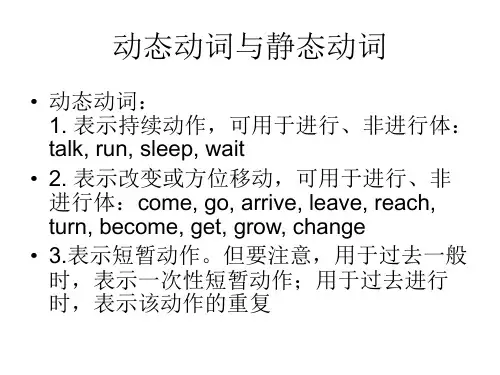
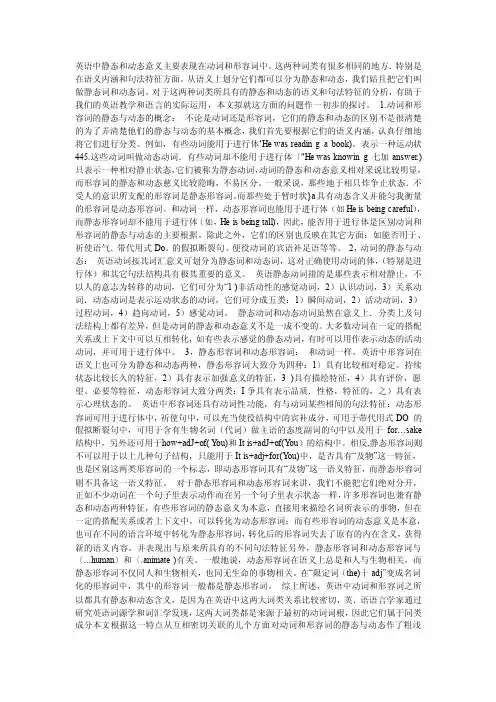
英语中静态和动态意义主要表现在动词和形容词中。
这两种词类有很多相同的地方.特别是在语义内涵和句法特征方面。
从语义上划分它们都可以分为静态和动态,我们姑且把它们叫做静态词和动态词。
对于这两种词类所具有的静态和动态的语义和句法特征的分析,有助于我们的英语教学和语言的实际运用,本文拟就这方面的问题作一初步的探讨。
1.动词和形容词的静态与动态的概念:不论是动词还是形容词,它们的静态和动态的区别不是很清楚的为了弄清楚他们的静态与动态的基本概念,我们首先要根据它们的语义内涵,认真仔细地将它们进行分类。
例如,有些动词能用于进行体…Hewasreading a book),表示一种运动状445.这些动词叫做动态动词.有些动词却不能用于进行体〔"He was knowing七加answ er.)只表示一种相对静止状态,它们被称为静态动词,动词的静态和动态意义相对采说比较明显,而形容词的静态和动态慈义比较隐晦,不易区分。
一般采说,那些地于相只炸争止状态.不受人的意识所支配的形容词是静态形容词。
而那些处于暂时状}a具有动态含义并能匀我衡量的形容词是动态形容词。
和动词一样,动态形容词也能用于进行体(如He is being careful),而静态形容词却不能用于进行体(如,He is being tall),因此,能否用于进行体是区别动词和形容词的静态与动态的主要根据。
除此之外,它们的区别也反映在其它方面;如能否用于、祈使语气.带代用式Do。
的假拟断裂句、便役动词的宾语补足语等等。
2,动词的静态与动态:英语动词按其词汇意义可划分为静态词和动态词,这对正确使用动词的体,(特别是进行体)和其它句法结构具有极其重要的意义。
英语静态动词指的是那些表示相对静止,不以人的意志为转移的动词,它们可分为“1)非活动性的感觉动词,2)认识动词,3)关系动词.动态动词是表示运动状态的动词,它们可分成五类:1)瞬间动词,2)活动动词,3)过程动词,4)趋向动词,5)感觉动词。

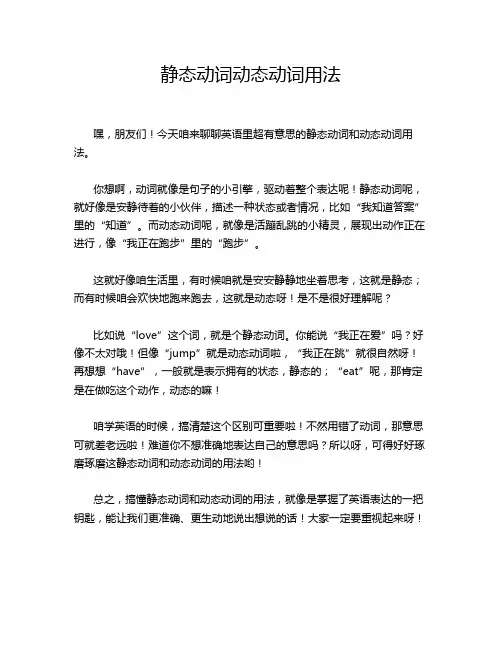
静态动词动态动词用法
嘿,朋友们!今天咱来聊聊英语里超有意思的静态动词和动态动词用法。
你想啊,动词就像是句子的小引擎,驱动着整个表达呢!静态动词呢,就好像是安静待着的小伙伴,描述一种状态或者情况,比如“我知道答案”里的“知道”。
而动态动词呢,就像是活蹦乱跳的小精灵,展现出动作正在进行,像“我正在跑步”里的“跑步”。
这就好像咱生活里,有时候咱就是安安静静地坐着思考,这就是静态;而有时候咱会欢快地跑来跑去,这就是动态呀!是不是很好理解呢?
比如说“love”这个词,就是个静态动词。
你能说“我正在爱”吗?好像不太对哦!但像“jump”就是动态动词啦,“我正在跳”就很自然呀!再想想“have”,一般就是表示拥有的状态,静态的;“eat”呢,那肯定是在做吃这个动作,动态的嘛!
咱学英语的时候,搞清楚这个区别可重要啦!不然用错了动词,那意思可就差老远啦!难道你不想准确地表达自己的意思吗?所以呀,可得好好琢磨琢磨这静态动词和动态动词的用法哟!
总之,搞懂静态动词和动态动词的用法,就像是掌握了英语表达的一把钥匙,能让我们更准确、更生动地说出想说的话!大家一定要重视起来呀!。
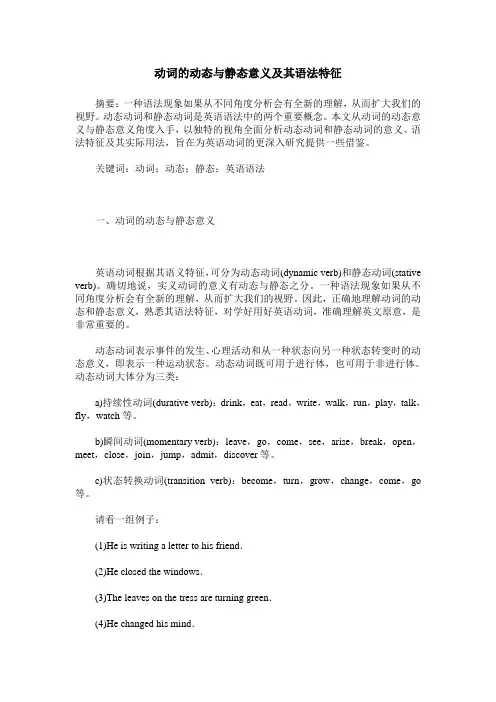
动词的动态与静态意义及其语法特征摘要:一种语法现象如果从不同角度分析会有全新的理解,从而扩大我们的视野。
动态动词和静态动词是英语语法中的两个重要概念。
本文从动词的动态意义与静态意义角度入手,以独特的视角全面分析动态动词和静态动词的意义、语法特征及其实际用法,旨在为英语动词的更深入研究提供一些借鉴。
关键词:动词;动态;静态;英语语法一、动词的动态与静态意义英语动词根据其语义特征,可分为动态动词(dynamic verb)和静态动词(stative verb)。
确切地说,实义动词的意义有动态与静态之分。
一种语法现象如果从不同角度分析会有全新的理解,从而扩大我们的视野。
因此,正确地理解动词的动态和静态意义,熟悉其语法特征,对学好用好英语动词,准确理解英文原意,是非常重要的。
动态动词表示事件的发生、心理活动和从一种状态向另一种状态转变时的动态意义,即表示一种运动状态。
动态动词既可用于进行体,也可用于非进行体。
动态动词大体分为三类:a)持续性动词(durative verb):drink,eat,read,write,walk,run,play,talk,fly,watch等。
b)瞬间动词(momentary verb):leave,go,come,see,arise,break,open,meet,close,join,jump,admit,discover等。
c)状态转换动词(transition verb):become,turn,grow,change,come,go 等。
请看一组例子:(1)He is writing a letter to his friend.(2)He closed the windows.(3)The leaves on the tress are turning green.(4)He changed his mind.通过例2和例3、例4的语义比较可以看出,瞬间动词与状态转换动词的区别是:前者一般没有结果意义,可以在短期内反复重复发生;后者有结果意义,一般不可以在短期内重复发生。
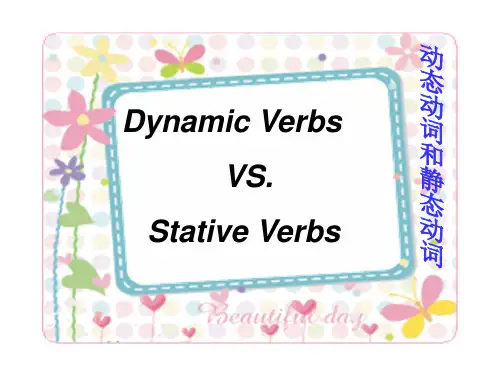
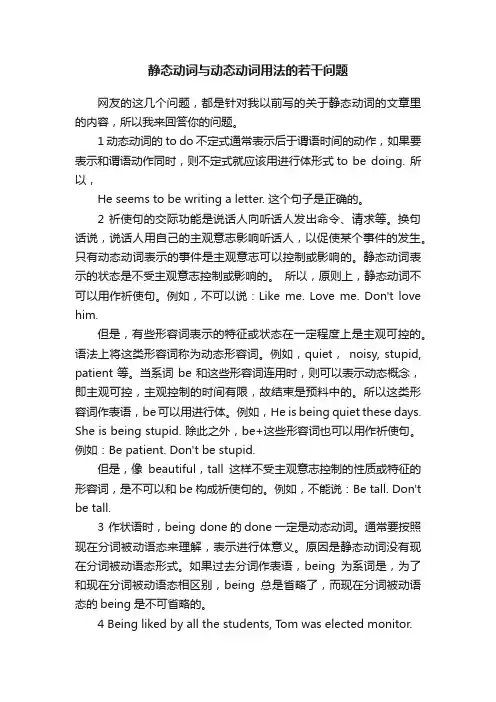
静态动词与动态动词用法的若干问题网友的这几个问题,都是针对我以前写的关于静态动词的文章里的内容,所以我来回答你的问题。
1 动态动词的to do不定式通常表示后于谓语时间的动作,如果要表示和谓语动作同时,则不定式就应该用进行体形式to be doing. 所以,He seems to be writing a letter. 这个句子是正确的。
2 祈使句的交际功能是说话人向听话人发出命令、请求等。
换句话说,说话人用自己的主观意志影响听话人,以促使某个事件的发生。
只有动态动词表示的事件是主观意志可以控制或影响的。
静态动词表示的状态是不受主观意志控制或影响的。
所以,原则上,静态动词不可以用作祈使句。
例如,不可以说:Like me. Love me. Don't love him.但是,有些形容词表示的特征或状态在一定程度上是主观可控的。
语法上将这类形容词称为动态形容词。
例如,quiet,noisy, stupid, patient等。
当系词be和这些形容词连用时,则可以表示动态概念,即主观可控,主观控制的时间有限,故结束是预料中的。
所以这类形容词作表语,be可以用进行体。
例如,He is being quiet these days. She is being stupid. 除此之外,be+这些形容词也可以用作祈使句。
例如:Be patient. Don't be stupid.但是,像beautiful,tall这样不受主观意志控制的性质或特征的形容词,是不可以和be构成祈使句的。
例如,不能说:Be tall. Don't be tall.3 作状语时,being done的done一定是动态动词。
通常要按照现在分词被动语态来理解,表示进行体意义。
原因是静态动词没有现在分词被动语态形式。
如果过去分词作表语,being为系词是,为了和现在分词被动语态相区别,being总是省略了,而现在分词被动语态的being是不可省略的。
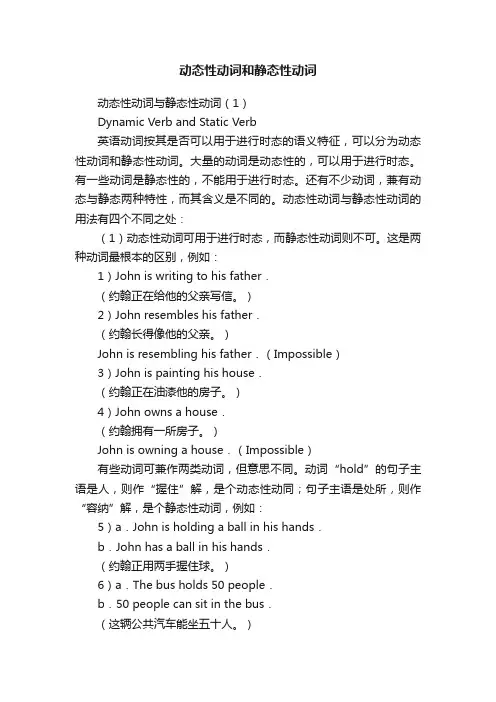
动态性动词和静态性动词动态性动词与静态性动词(1)Dynamic Verb and Static Verb英语动词按其是否可以用于进行时态的语义特征,可以分为动态性动词和静态性动词。
大量的动词是动态性的,可以用于进行时态。
有一些动词是静态性的,不能用于进行时态。
还有不少动词,兼有动态与静态两种特性,而其含义是不同的。
动态性动词与静态性动词的用法有四个不同之处:(1)动态性动词可用于进行时态,而静态性动词则不可。
这是两种动词最根本的区别,例如:1)John is writing to his father.(约翰正在给他的父亲写信。
)2)John resembles his father.(约翰长得像他的父亲。
)John is resembling his father.(Impossible)3)John is painting his house.(约翰正在油漆他的房子。
)4)John owns a house.(约翰拥有一所房子。
)John is owning a house.(Impossible)有些动词可兼作两类动词,但意思不同。
动词“hold”的句子主语是人,则作“握住”解,是个动态性动同;句子主语是处所,则作“容纳”解,是个静态性动词,例如:5)a.John is holding a ball in his hands.b.John has a ball in his hands.(约翰正用两手握住球。
)6)a.The bus holds 50 people.b.50 people can sit in the bus.(这辆公共汽车能坐五十人。
)动词have可兼作两种类型。
当作动态性动词用时,表示动作的发生或过程,相当于take,get,receive,eat,drink等词,可用于进行时态。
当作静态性动词用时,表示“拥有”的概念,相当于own,possess等词,没有进行时态,例如:7)a.I was having my coffee quietly.b.I was drinking my coffee quietly.(当时我正在默默地喝咖啡。
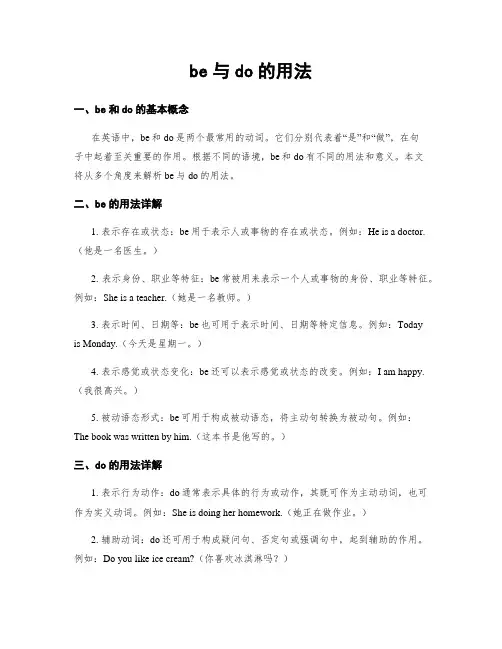
be与do的用法一、be和do的基本概念在英语中,be和do是两个最常用的动词。
它们分别代表着“是”和“做”,在句子中起着至关重要的作用。
根据不同的语境,be和do有不同的用法和意义。
本文将从多个角度来解析be与do的用法。
二、be的用法详解1. 表示存在或状态:be用于表示人或事物的存在或状态。
例如:He is a doctor.(他是一名医生。
)2. 表示身份、职业等特征:be常被用来表示一个人或事物的身份、职业等特征。
例如:She is a teacher.(她是一名教师。
)3. 表示时间、日期等:be也可用于表示时间、日期等特定信息。
例如:Todayis Monday.(今天是星期一。
)4. 表示感觉或状态变化:be还可以表示感觉或状态的改变。
例如:I am happy.(我很高兴。
)5. 被动语态形式:be可用于构成被动语态,将主动句转换为被动句。
例如:The book was written by him.(这本书是他写的。
)三、do的用法详解1. 表示行为动作:do通常表示具体的行为或动作,其既可作为主动动词,也可作为实义动词。
例如:She is doing her homework.(她正在做作业。
)2. 辅助动词:do还可用于构成疑问句、否定句或强调句中,起到辅助的作用。
例如:Do you like ice cream?(你喜欢冰淇淋吗?)3. 表示职业、工作:do有时也被用于表示职业或工作,代表具体的行业领域。
例如:He does computer programming for a living.(他靠计算机编程谋生。
)4. 表示完成任务或活动:do可以表示完成某项任务或活动,常与特定的名词连用。
例如:I need to do laundry.(我需要洗衣服。
)四、be和do的区别虽然be和do都是常见的动词,但它们在使用上有一些明显的区别。
1. be强调状态及性质,而do更多强调具体行为。

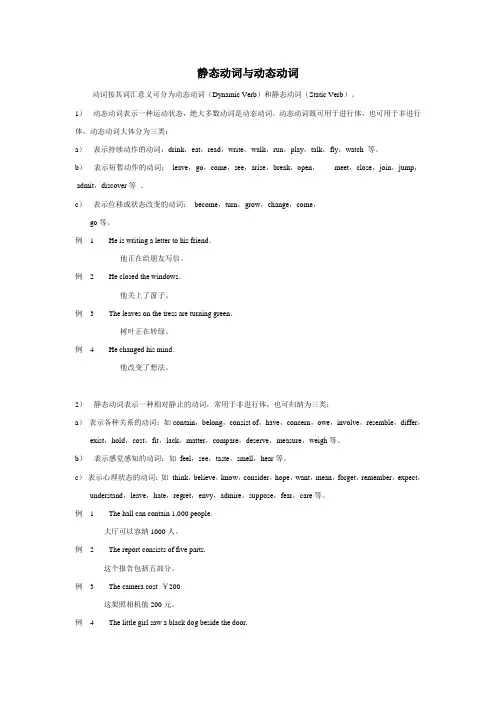
静态动词与动态动词动词按其词汇意义可分为动态动词(Dynamic Verb)和静态动词(Static Verb)。
1)动态动词表示一种运动状态,绝大多数动词是动态动词。
动态动词既可用于进行体,也可用于非进行体。
动态动词大体分为三类:a)表示持续动作的动词:drink,eat,read,write,walk,run,play,talk,fly,watch 等。
b)表示短暂动作的动词:leave,go,come,see,arise,break,open,meet,close,join,jump,admit,discover等。
c)表示位移或状态改变的动词:become,turn,grow,change,come,go等。
例 1 He is writing a letter to his friend.他正在给朋友写信。
例 2 He closed the windows.他关上了窗子。
例 3 The leaves on the tress are turning green.树叶正在转绿。
例 4 He changed his mind.他改变了想法。
2)静态动词表示一种相对静止的动词,常用于非进行体,也可归纳为三类:a)表示各种关系的动词:如contain,belong,consist of,have,concern,owe,involve,resemble,differ,exist,hold,cost,fit,lack,matter,compare,deserve,measure,weigh等。
b)表示感觉感知的动词:如feel,see,taste,smell,hear等。
c)表示心理状态的动词:如think,believe,know,consider,hope,want,mean,forget,remember,expect,understand,leave,hate,regret,envy,admire,suppose,fear,care等。
动态性动词与静态性动词(1)Dynamic Verb and Static Verb英语动词按其是否可以用于进行时态的语义特征,可以分为动态性动词和静态性动词。
大量的动词是动态性的,可以用于进行时态。
有一些动词是静态性的,不能用于进行时态。
还有不少动词,兼有动态与静态两种特性,而其含义是不同的。
动态性动词与静态性动词的用法有四个不同之处:(1)动态性动词可用于进行时态,而静态性动词则不可。
这是两种动词最根本的区别,例如:1)John is writing to his father.(约翰正在给他的父亲写信。
)2)John resembles his father.(约翰长得像他的父亲。
)John is resembling his father.(Impossible)3)John is painting his house.(约翰正在油漆他的房子。
)4)John owns a house.(约翰拥有一所房子。
)John is owning a house.(Impossible)有些动词可兼作两类动词,但意思不同。
动词“hold”的句子主语是人,则作“握住”解,是个动态性动同;句子主语是处所,则作“容纳”解,是个静态性动词,例如:5)a.John is holding a ball in his hands.b.John has a ball in his hands.(约翰正用两手握住球。
)6)a.The bus holds 50 people.b.50 people can sit in the bus.(这辆公共汽车能坐五十人。
)动词have可兼作两种类型。
当作动态性动词用时,表示动作的发生或过程,相当于take,get,receive,eat,drink等词,可用于进行时态。
当作静态性动词用时,表示“拥有”的概念,相当于own,possess等词,没有进行时态,例如:7)a.I was having my coffee quietly.b.I was drinking my coffee quietly.(当时我正在默默地喝咖啡。
关于静态动词和动态动词,以及延续性动词和短暂动词动词的语义分类(动态、静态、延续、短暂、终结性、非终结性)与时态有着密不可分的关系,直接影响动词时态的选用。
例如,静态动词(或者动词的静态意义)不可用进行体。
延续性动态动词不可以用一般现在时表示说话时发生的事件。
英美国家的人可以不学语法,可以不知道什么动态动词静态动词,照样说一口标准的母语。
中国英语专业的学生可以不学语法,有幸在英语国家工作或生活的人也是如此。
因为他们耳闻目染的环境,随时可以模仿、使用的正确的表达方式。
可是作为非英语专业的学习者,掌握了语法,则无疑是学习英语的有利工具,可以起到事半功倍、举一反三的效果。
但语法不能代替语言学习,不能脱离大量的阅读实践,这是不言而喻的。
所以,那些有幸在国外学习工作的人,没有理由讽刺、鄙视在国内学语法的人。
系统学语法还是要看语法书,国内的或者国外的都可以。
在网络上学只能针对某个具体问题提问,无法学到系统的东西。
网上鲜有对静态动词、动态动词以及进一步分类作全面论述的。
但语法著作上有。
夸克《大全》英文版P200-209,讲述动词的分类以及不同动词类别与时态的关系。
The Cambridge Grammar of the English Language 也 P168-171 讲述动词的分类及其与时态的关系。
如果一个英语学习者能够看懂并完全理解以上二本英文原著的上述内容,该学习者就根本无须来答疑网提问的。
所以,用中文介绍上述有关内容给学习者,则正是这个阶段学习者所需要的。
这有什么可奇怪的。
有几个中国学生学时态是在网上学的?动词的分类如果与时态学习没有关系,夸克和Huddleston是闲着没事干了用如此篇幅在时态时讨论动词的分类吗?我觉得有些人没有必要阴阳怪气的嘲讽吧。
sunyue8888网友可以耐心读一下上述二本著作中我提到的那些页码的内容,我相信一定对你的英语学习是大有帮助的。
1 )英语表示情感、情绪等心理活动结果状态(不是心理活动本身)的动词,都属于静态动词。
陈才英语教育及辅导中心英语动态静态动词用法2018年12月20日动态动词和静态动词深度解析英语动词有时态、语态、语气、非谓语动词等诸多变化形式,每种形式都隐含某种意义,即内容决定形式,形式反映内容。
其中动词基本词义是影响动词形式的非常重要的内容之一。
A:根据动词语义是否完整可以分为以下2种动词。
【一】不及物动词:语义完整不需要接宾语【二】及物动词:语义不完整需要接宾语。
B:根据动词表示的是事件还是状态可以分为以下2种动词。
【一】动态动词【1】延续性动词:可与持续时间状语连用。
She has worked here for ten years.She writes to her parents once a week. (习惯)(write为延续性动词)【2】非延续性动词:不可与持续时间状语连用。
She always pat his head whenever she sees him. (习惯)(pat为瞬间动词)【3】终结性动词:终结性动词的语义重心在动作的结束和完成。
即使不用完成体,一般体也表示动作的结束和完成。
He wrote a book。
他写了一本书。
He wrote a letter. 他写了一封信。
He made a chair. 他制作了一把椅子。
He sang a song.他唱了一首歌曲。
备注:终结性动词的动作如果没有结束,则需要使用进行体:He was writing a letter. 他在写一封信。
He was making a chair.他在制作一把椅子。
【4】非终结性动词:表示非终结动词没有终结意义动词。
He wrote for two hours.他写了4小说。
He was writing.他在写作。
He wrote till 6 o'clock. 他一直写到6点钟。
【5】状态转换动词:表示转换为习惯意义的动词。
More and more people die of cancers. (习惯)(die为转态动词)越来越多的人死于癌症。
(知识点)中常见的动态动词与静态动词动词是语言中最基本且最常用的词类之一。
在英语中,动词可以分为动态动词和静态动词两种类型。
动态动词表示动作或者事件的进行,而静态动词则表示状态、感觉、思维等静态的概念。
本文将介绍一些常见的动态动词和静态动词,帮助读者更好地理解和运用这两种动词。
动态动词是表示动作或者事件的进行的动词。
这类动词可以说明主语正在进行的动作,并且可以用进行时态来表达。
下面是一些常见的动态动词:1. run(奔跑):I am running in the park.2. eat(吃):He is eating an apple.3. write(写):She is writing a letter.4. play(玩耍):They are playing soccer.5. dance(跳舞):We are dancing at the party.6. swim(游泳):The children are swimming in the pool.7. sing(唱歌):He is singing a song.8. speak(说话):She is speaking English.9. work(工作):They are working in the office.10. study(学习):I am studying for the exam.静态动词是表示状态、感觉、思维等静态概念的动词。
这类动词无法用进行时态来表达,通常用于表示主语的状态或者属性。
以下是一些常见的静态动词:1. be(是):He is a doctor.(他是一名医生。
)2. have(有):She has a car.(她有一辆车。
)3. belong(属于):This book belongs to me.(这本书属于我。
)4. know(知道):They know the answer.(他们知道答案。
)5. like(喜欢):I like this movie.(我喜欢这部电影。
静态动词和动态动词的区别这位网友对终结性动词的理解是有误的。
所谓终结性动词,是指这类动词表示的动作结束时并不导致状态的改变。
He walked for 10 miles. 主语走了10英里,动作结束后,主语还是原来的主语,他的状态没有发生改变。
所以动态动词表示的动作的结束都是在预料之中的。
动态动词要么表示事件的发生,要么表示习惯意义。
当持续性非终结动词表示事件意义时,动词本身就包含了动作的开始、持续、然后结束。
例如:He walked to the shop. 当这个动作没有结束时,就要用进行体: He was walking to the shop. 当这个事件在说话时发生时,我们描述这个动作就要说,He is walking to the shop. 而不是He walks to the shop. 因为他走到商店这个动作不可能在你说这句话的这么短暂的时间内发生并结束。
会结束而未结束,就要用进行体。
虽然我们可以见到 He walked on the street. 但这个句子暗示的是他在街上走的整个动作(发生并结束)。
如果没有结束就要用进行体。
例如:He was knocked over by a motorcycle while he was walking on the street. 而不是He was knocked over by a motorcycle while he walked on the street. 但静态动词则不用进行体:He was knocked over by a motorcycle while he was deeo in thinking.再看静态动词表示现在的状态,和持续性非终结动词表示现在的事件。
Now I like football. 静态动词Now I walk on the street. (x) 持续非终结动词Now I am walking on the street.Now it rains. (x) 持续非终结动词Now it is raining.。
关于英语动态动词与静态动词的用法李丽华(鞍山师范学院外语系鞍山114005)摘要:本文从英语动态动词和静态动词的分类入手,根据分析和比较的结果,系统地阐述动态动词和静态动词的用法。
关键词:动态动词静态动词Abstract: This thesis elaborates the usage of the English dynamic and stative verbs systematically and focusses the attention on the accurate use of various verbs in the Englishlanguage.Key Wrds: Dynamic verbs Stative verbs英语中的动态动作和静态状态可以表现在动词中,从语义角度讲,动词可以分为动态和静态。
本文着重就动态动词(dynamic verbs)和静态动词(stative verbs)的语义和句法特征做进一步的分析。
一、动词(dynamic verbs)和静态动词(stative verbs)的概念及分类。
实义动词按其语义特征可以分为动态动词和静态动词。
1.动态动词(dynamic verbs):表示运动状态的动词。
这类动词分为五种:(1)活动动词(activity verbs)(2)过程动词(process verbs)(3)感觉动词(verbs of bodily sensation)(4)过渡性动词(transitional verbs)(5)瞬间动词(momentary verbs)2.静态动词(stative verbs):表示相对静止状态的动词。
这类动词分为三种:(1)感觉动词(verbs of perception)(2)认识动词(verbs of cogition)(3)关系动词(relation verbs)二、动态动词(dynamic verbs)1.活动动词(activity verbs):这类动词表示动作的发出者的有意识的,主动的行为。
这类动词有:ask,write,listen,play,run,keep,work etc.One of the students asked me a question.The girl writes to her mother once a week.2.过程动词(process verbs):这类动词表示“过程”含有逐渐过渡的语义,通常情况下,表示动作转化为状态。
这类动词有:change,grow,get,widen,become,mature,deteriorate etc.The village has changed a great deal since we last visited it.It is growing cold.3.感觉动词(verbs of bodily sensation):这类动词表示客观事物的个别特征在人体中引起的反映。
这类动词有:ache, feel, hurt, itch etc.My back was hurting.Are your mosquito bites still itching?4.过渡性动词(transational verbs):这类动词表示动作由一个阶段逐渐发展而转入另一种状态。
这类动词有:arrive, die, fall, land, leave, lose etc.The train arrived at the station.Tom’s grandfather died five years ago.这里需要指出的是当上述过渡性动词用于进行体时,表达的不是动作达到的语义,而是过渡状态。
The train was arriving. (火车快到站了.)Tom’s grandfather was dying. (汤姆的祖父快要去世.)5.瞬间动词(momentary verbs)这类动词表示瞬间发生随即完成的动作。
这类动词有:hit,jump,tap,knock,kick,nod,meet,shoot,drop,etc.The boss hit the boy on the head.The teacher tapped the child on the shoulder.值得语言学者重视的是:瞬间动词一旦用于进行体,常表示重复性动作。
The boss was hitting the boy on the head. (连续打击)The teacher was tapping the child on the shoulder. (连续拍打)其中begin 虽为瞬间动词,但用于进行体中,并不表示重复,而是表示“刚刚开始”:You are beginning to wonder whether the plan can be practicable.通过对上述动态动词(dynamtic verbs) 的语义特征进行的分析, 可以概括为以下几点用法:1)动态动词可以用于祈使句。
Stop talking.Please open the door.2)动态动词可以用于进行体。
The students are reading the text.The weather is changing for the better.3)动态动词可以用于复合宾语中。
I told him to go to the clinic.She asked the student write the composition.4)动态动词可以用于带有do 代词形势得假拟分裂句。
What I did was to make notes.What I did was to leav.三、静态动词(stative verbs)1.感觉动词(verbs of perception):感觉动词用来表示主体的思维和五官活动的动词。
这类动词有:see, hear, smell, sound, taste, etc.We can smell something burning.Can you taste onion in the soup?2.认识动词(verbs of cognition):认识动词用来表示各种思想感情及心理状态。
这类动词有:astonish,desire,believe,love,hate,remember,know,want,wish,think,recognize,etc.His words astonished all.I didn’t recognized her.3.关系动词(relational verbs):关系动词用来表示主体和其他事物之间的静止关系或状态。
这类动词有:apply to,be,belong to,concern,resemble,consist of,contain,cost,depend on,deserve,fit,have,remain,seem,need,own,etc.The rules apply to all undertakings.Water consists of hydrogen and oxygen.通过对上述静态动词(stative verbs)的语义分析,可以概括为以下几点:1)静态动词不能用于祈使句。
不能说:Hear, someone is knocking at the door.Know him, please.2)静态动词一般不以进行体形式出现。
不能说:I am knowing that Jack went there.Our class is consisting of 20 students.3)静态动词不能用于复合宾语(complex objects)中。
不能说:I ask him to smell something unpleasant.I advised him remember it.4)静态动词不能用于带有do 代词形式的假拟分裂句。
不能说:What I did was to feel pain on my head.What she did was to dislike the novel.四、动态动词(dynamic verbs)和静态动词(stative verbs)的其他用法。
以上对动态动词和静态动词的语义和句法特征进行了分析,两者之间存在一些固有的差异,但是并非一成不变的,在一定语义中可以互相转化。
1.在一定的语境中,静态动词可以转化为动态动词。
I can smell gas, it smalls awful. (汽油味是无意识闻到的,闻起来很难闻。
)I can hear someone singing. (唱歌是无意识听到的。
)2.有的静态动词转化为动态用法,可以用于祈使句:Don’t be late.(be 在这里不是“是”的意思,而是与表语late一起构成迟到的行为。
) Know the answer.(know 在此处不是“知道”的意思,而是“弄清”。
)3.一些静态动词可以用于进行体。
1)表示某一具体时间内的暂时心理活动:She is being clever. (暂时性)His father trusted him. (经常性)His father is trusting him. (当时的情况)2)表示动作的主体主动地有意识地进行某一动作:I’m feeling this desk.(主动性)I’m tasting those wines for nearly an hour.(主动性)3)表示某种心理,情感的行为反复发生,并且含有感情色彩:What are you wanting this time?(意味来过几次,每次都要不同的东西,而这次又要什么?话语中有不耐烦的情绪。
) She is continually distrusting her judgement.(意味着反复发生的行为却不相信自己。
)4)词汇意义有所变化,这时候它们在不同的场景下,可以用不同的其它动词来代替:She is hearing the lectures at the university.( hearing = listening to)Tome is seeing the sights. (seeing = visiting)5)表示某种认识,感觉的获得有一个持续的过程:We are finding this problem is more complicated tha we expected.(缓慢的一个过程)They are realizing (at last) that they must give up smokinfg.(逐渐的过程)6)表示“开始”的含义:I’m forhetting the German language.(forgetting = beginning to forget)He is understanding this better.(understanding = beginning to understand)7) 表示婉转,客气的语气:I’m hoping you will come and play.(我真希望您来玩。